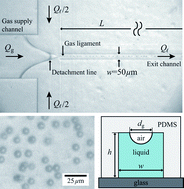Microbubble generation in a co-flow device operated in a new regime†
Abstract
A new regime of operation of PDMS-based flow-focusing microfluidic devices is presented. We show that monodisperse microbubbles with diameters below one-tenth of the channel width (here w = 50 μm) can be produced in low viscosity liquids thanks to a strong pressure gradient in the entrance region of the channel. In this new regime bubbles are generated at the tip of a long and stable gas ligament whose diameter, which can be varied by tuning appropriately the gas and liquid flow rates, is substantially smaller than the channel width. Through this procedure the volume of the bubbles formed at the tip of the gas ligament can be varied by more than two orders of magnitude. The experimental results for the bubble diameter db as function of the control parameters are accounted for by a scaling theory, which predicts db/w ∝ (μg/μ )1/12(Qg/Q
)1/12(Qg/Q )5/12, where μg and μ
)5/12, where μg and μ indicate, respectively, the gas and liquid viscosities and Qg and Q
indicate, respectively, the gas and liquid viscosities and Qg and Q are the gas and liquid flow rates. As a particularly important application of our results we produce monodisperse bubbles with the appropriate diameter for therapeutic applications (db ≃ 5 μm) and a production rate exceeding 105 Hz.
are the gas and liquid flow rates. As a particularly important application of our results we produce monodisperse bubbles with the appropriate diameter for therapeutic applications (db ≃ 5 μm) and a production rate exceeding 105 Hz.

- This article is part of the themed collection: 10th Anniversary: Focus on The Netherlands

 Please wait while we load your content...
Please wait while we load your content...